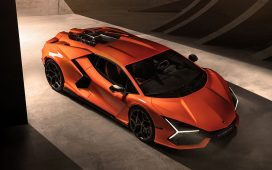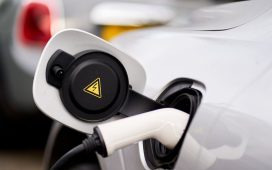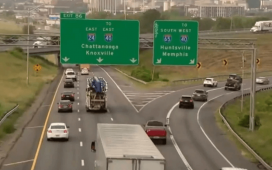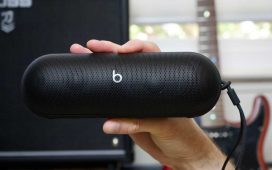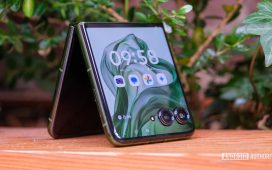Building cars isn’t for the faint of heart. It’s a long, arduous process that requires precise planning, prepping and executing. And sometimes things don’t go exactly as planned. That’s part of the growing process. It’s something that electric automaker Rivian is experiencing right now—and that could tremendously set back its growth this year.
Welcome back to Critical Materials, your daily roundup for all things EV and automotive tech. Today, we’re chatting about Rivian’s supply chain fumble that cost it 18% of its annual production for 2024, Fisker’s fight with recall labor costs amid bankruptcy and Tesla’s latest move to help out those affected by Hurricane Milton. Let’s jump in.
30%: Rivian Just Fumbled Its Supply Chain. Hard.

Rivian
Just when you thought parts shortages were a thing of the past, Rivian is here to remind you that a simple fumble can mean all the difference between 57,000 vehicles being built and delivered and 47,000. Yeah, we know the napkin math here is 10,000 units—that’s not the point. The real story is how Rivian got here, and this one is truly a rookie mistake.
Last week, Rivian announced that it was slashing the targeted output of its vehicles by as much as 18%. It came as a shock to many, and Rivian’s stock price reflected it, but nobody really knew why the production volume would shrink. As it turns out, the reason comes down to a bungled deal with one of its core suppliers.
You’ve probably never heard of Essex Furukawa before, and that’s okay. It’s not like everyone has a Furukawa-branded refrigerator in their house, right? That’s because the company produces a very specific component for Rivian: the copper windings in its EV motors.
Here’s Bloomberg with the scoop:
The carmaker miscalculated when communicating supply and demand needs with Essex, Rivian’s sole supplier of what are essentially copper wires that carry the electric current inside the EV motors, said the people, who asked not to be identified discussing the confidential matter.
Essex Furukawa, a unit of Superior Essex Inc., subsequently committed its machines to support other customers, the people said. Rivian has identified other suppliers capable of providing appropriate replacements, but at too high a cost at such short notice.
So, let’s back up to investigate what exactly happened that caused the shortage in the first place. Typically, automakers make vehicle output predictions pretty far in advance, so it’s not like Rivian underestimated the number of vehicles it planned to produce that significantly, right?
According to Bloomberg, Rivian somehow miscalculated the number of components that it would need when communicating its supply needs with Essex Furukawa. And as a result, the supplier subsequently committed the number of units produced in excess of Rivian’s needs to other customers.
It’s unclear if Rivian may have miscommunicated the number of vehicles it planned to produce, if someone made a calculation error or if someone forgot that some trucks have two (or three) electric motors powering the wheels. And in the end, it doesn’t really matter, because now the automaker is short critical components needed to build not just its R1-series pickup and SUV, but also its electric delivery vans (EDVs) for Amazon.
Production shortages happen, though. That’s not abnormal. However, without having a backup provider to make the parts in Furukawa’s absence—and those tapped for the task being too expensive at such short notice—Rivian’s a bit stuck in the water.
Let’s chalk this one up to growing pains. Rivian is still relatively new to the mass-market EV game. However, with its hotly-anticipated Rivian R2 coming very soon, its battle for EV SUV supremacy against the Tesla Model Y will throw new hurdles at the baby-faced automaker. It better take these lessons to heart to ensure a successful future.
60%: Fisker Recall “Scheme” Deemed Illegal: It Can’t Charge Customers For Repairs

File this one under “well, duh.” It turns out that bankrupt EV startup Fisker actually can’t force its customers to pay to have their recalled cars fixed. In fact, the U.S. Department of Justice called foul on Fisker’s whole we’re-not-paying-for-labor attitude and said on Monday that requiring customers to do so would be—get this—illegal.
Fisker’s fickle failure has been quite the fracas to follow. Just as it started to go belly-up, the automaker faced a series of fleet-wide recalls that would seriously reduce the funds it has available for its ongoing bankruptcy proceedings. Fisker attempted to cop out of the expense by claiming that it was only obligated to make the parts available and that actually fixing the vehicle would be a customer-paid service.
The DOJ says that’s a big no-no, according to Reuters.
“The Safety Act is clear that all costs associated with remedying defective and noncompliant vehicles must be covered by the manufacturer,” wrote the DOJ in its filing. It later continued, noting that attempting to limit bankruptcy funds available to address its safety recalls “lacks any basis in law.”
Fisker’s recall FAQ page currently reads the following regarding the proposed customer-funded labor costs:
For the two recalls that require physical inspection and repair related to the outer door handles and electric water pumps, Fisker will provide the necessary parts and diagnostic tools at no cost to you, but as of now, the customer will be responsible for the labor costs incurred to complete the repair(s).
Through the bankruptcy process, Fisker was able to fund the purchase of service parts while funding for labor costs is not currently available. It was a priority to make service parts available to avoid delaying these two safety recalls. Fisker is diligently working to secure funding for these labor costs and will update you as and when appropriate.
Fisker’s labor estimate (which includes the replacement of all four outer door handles, the cabin electric water pump, and the exterior door handle check) comes out to 3.1 hours of labor, though manufacturer estimates often underestimate the real-world time of repairs.
“[T]he Safety Act requires manufacturers—not vehicle owners—to cover all remediation expenses,” wrote the DOJ. “This ‘owner reimbursement’ scheme compounds Fisker’s ongoing violation of the Safety Act.”
“A manufacturer’s filing of a petition in bankruptcy under chapter 7 or chapter 11 does not negate the manufacturer’s duty to comply.”
And what about those customers who have already paid out of pocket to have the recalls performed? The DOJ says that they never should have paid in the first place and wouldn’t object to the customers being reimbursed in some way.
I feel bad for the Fisker owners who got swindled in this whole mess. The Ocean was a really well-designed car (at least aesthetically) with a lot of big promises from Henrik & Co. Sadly, the company was marched into the abyss by its alleged mismanagement—and with it the hopes and dreams of anyone who wasn’t able to get out of their underwater loan quickly enough.
But, hey, maybe the third time’s the charm if Henrik is feeling up for another automotive challenge. Or maybe the U.S. Securities and Exchange Commission’s new investigation will be the final nail in the coffin for future Fisker ventures.
90%: Tesla Is Deploying Mobile Superchargers to Prep For Hurricane Milton

Hurricane Milton is expected to wreak havoc on the Gulf Coast this week and that means the usual storm prep is underway. Folks are stockpiling supplies, boarding up windows, and bracing for what could be one of the worst storms in a century. But there’s one thing that might be a bit overlooked until its too late: fueling up.
For EVs, that means preparing ahead for extended power outages for anyone disconnected from the grid. Tesla is recommending people charge their vehicle to 100%—something typically only recommended in the U.S. for its now-discontinued LFP cars—in preparation for the storm. And for those who expect to need more, Tesla is preparing to deploy a fleet of mobile Supercharging stations to quickly address charging in areas that need it the most.
“Pre-hurricane, we are focused on uptime of Superchargers,” writes Tesla on X. “Post-hurricane, we will be focused on restoration and are prepared to deploy mobile Superchargers powered by Megapacks where access to charging is most impacted.”
Think of Tesla’s Megapack like a giant battery pack. In this configuration, it’s loaded onto a trailer and hauled around from location to location using a Semi truck. The electricity is then dispersed to cars via Tesla Supercharger stalls bolted to the same trailer. It’s a smart, makeshift solution born out of necessity that can really prove to be useful during emergencies when infrastructure (or a lack thereof) can prove to be challenging.
The Megapack stores a massive 3 Megawatt-hours of electricity (that’s 3,000 kilowatt-hours). It might seem like a lot, but that doesn’t hold as much charge as you think when it’s the only Supercharger with power in the area.
Depending on the Tesla vehicle at the charger and how much energy it needs, the Megapack could be quickly depleted. For sake of easy numbers, let’s just assume everyone showing up to the charger is charging their Tesla from a fully-depleted battery to 100%. As unlikely as that is, it makes for some easy math. 3,000 kWh of energy is only enough to completely charge 40 Long Range Model 3s, 52 Standard Range Model 3s, or 30 Long Range Model S or Xs. And considering that Florida has the second-highest number of EV registrations in the U.S., cars in need of an electricity bump may quickly sip up available power.
These mobile chargers aren’t new by any means. In fact, Tesla has been using them for about five years now to address charging needs at various locations. And, of course, to show off its energy products at investor events.
Former Tesla executive Drew Baglino once said that the automaker designed its mobile Megapack Chargers to fit a dual-purpose need. First, to address surge capacity (think holidays, sporting events, or—in typical Tesla-fashion—rocket launches). Second, to handle emergency service needs like evacuations or “power supply challenges” such as extended outages.
That being said, it’s a good move by Tesla to deploy these chargers. People affected by Milton (and Helene, which wreaked havoc on Florida just two weeks ago) will be able to charge up their car despite potential lingering power outages, Tesla gets to advertise the usefulness of its commercial Megapack product, and the automaker gets some good publicity for helping out during a natural disaster—and, boy, does Tesla need it right now.
100%: Are EV Startups Too Risky To Buy From?

With Rivian fumbling the ball and Fisker’s masterful gambit leaving its customers in the lurch, new car buyers might be feeling a bit shaky on the whole “EV startup” approach to carmaking.
These aren’t the only examples either. There’s Faraday Future and Canoo, which have both been slowly showing signs of trouble, and then automakers like Lordstown Motors (and now Fisker) which have effectively gone defunct. Even other brands like Lucid, which just had a relatively strong Q3, are still reliant on external funding to stay afloat.
The problem is that these small companies have really, really good ideas. They’re pushing innovative technology, cool software features and connectivity that is effectively pushing legacy automakers out of their comfort zones and furthering the industry. It’s probably fair to assume that we wouldn’t have had the recent progress in EVs if it weren’t for smaller companies shoving Big Auto into the future.
So here’s the question: With all of these issues finally coming to a head, are you hesitant to buy an EV from a small “startup” automaker, or does size not matter?
Let me know in the comments.
Contact the author: rob.stumpf@insideevs.com

